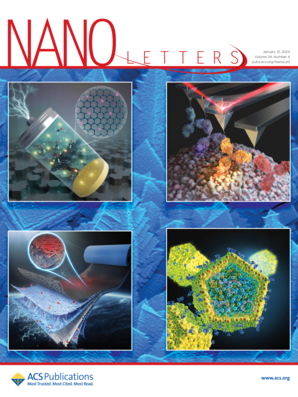In Situ Gas-Phase 4D-STEM for Strain Mapping during Hydride Formation in Palladium Nanocubes
IF 9.6
1区 材料科学
Q1 CHEMISTRY, MULTIDISCIPLINARY
引用次数: 0
Abstract
The uptake and release of hydrogen are key parameters for hydrogen storage materials. Lattice strain offers a powerful way to tune hydride formation in metal nanoparticles. However, the role of strain on hydride formation is difficult to assess on a single nanoparticle level due to the lack of in situ characterization tools to quantify strain in the presence of a gas. Here, we achieve a dynamic, in situ study on the reversible hydride formation in individual palladium nanocubes by applying 4D scanning transmission electron microscopy (4D-STEM) in the presence of 1 bar H2 and quantitatively assess the lattice strain with subnanometer resolution. Upon hydride formation at 125 °C, the Pd lattice expands by ∼3.1% and relaxes back upon hydrogen desorption at 200 °C. Our in situ 4D-STEM approach is relevant to a wide range of nanoparticle systems and applications, including catalyst- and gas-sensing materials.

求助全文
约1分钟内获得全文
求助全文
来源期刊

Nano Letters
工程技术-材料科学:综合
CiteScore
16.80
自引率
2.80%
发文量
1182
审稿时长
1.4 months
期刊介绍:
Nano Letters serves as a dynamic platform for promptly disseminating original results in fundamental, applied, and emerging research across all facets of nanoscience and nanotechnology. A pivotal criterion for inclusion within Nano Letters is the convergence of at least two different areas or disciplines, ensuring a rich interdisciplinary scope. The journal is dedicated to fostering exploration in diverse areas, including:
- Experimental and theoretical findings on physical, chemical, and biological phenomena at the nanoscale
- Synthesis, characterization, and processing of organic, inorganic, polymer, and hybrid nanomaterials through physical, chemical, and biological methodologies
- Modeling and simulation of synthetic, assembly, and interaction processes
- Realization of integrated nanostructures and nano-engineered devices exhibiting advanced performance
- Applications of nanoscale materials in living and environmental systems
Nano Letters is committed to advancing and showcasing groundbreaking research that intersects various domains, fostering innovation and collaboration in the ever-evolving field of nanoscience and nanotechnology.
 求助内容:
求助内容: 应助结果提醒方式:
应助结果提醒方式:


